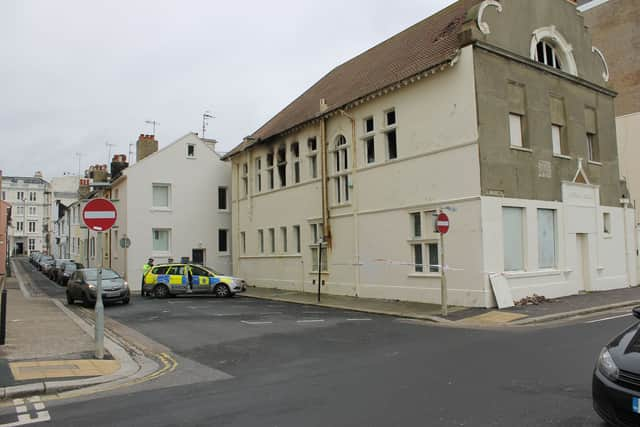Medina House: The treasurable remnant of great bathing tradition


It is a quaint, Dutch-gabled survival in a stretch of seafront dominated by big bland blocks. Although it is not listed, English Heritage describe it as 'a characterful building that embodies historical significance'. It is yet another in the lamentable catalogue of heritage assets left to rot.
Medina House, in King's Esplanade, Hove, adjoining Marrocco's restaurant, is all that remains of a sea-water bathing complex, Medina Baths, dating from 1894. The larger section, to the west, which included a men's bath, was demolished in 1976, but the smaller women's section, tenanted latterly by a diamond-cutting business, managed to hang on. Hove Borough Council sold it in 1997 to a developer, Sirus Taghan, who demolished the actual bathhouse, leaving its colourful tilework exposed to the elements. He also let squatters and caravan-dwellers live on the premises for many years. He has proposed various schemes for the site, including an 18-storey tower in 2002, and one that resembled a toppling pile of plates in 2006. Just before Christmas, fire broke out, prompting renewed calls for the building to be compulsorily purchased and a more appropriate use - whether as community centre, museum, or housing - to be found.
Advertisement
Hide AdAdvertisement
Hide AdHistorically, it is the final modest survivor of a long tradition of sea-water and Turkish bathing establishments, going back to the very origins of Brighton's fashionable success. Dr Richard Russell, with his sea-bathing premises, Russell House, sited where the Royal Albion now stands, began the whole thing in 1753. His disciple Dr John Awsiter's baths, opened in 1769 in Pool Valley - later becoming Wood's Original Hot and Cold Sea-water Baths, and later still Creak's Baths - survived until 1861.


The most famous of all, Mahomed's Baths, were opened in 1786 by the Indian Sake Deen Mahomed and his Irish wife. This stood on the site of the later Queen's Hotel, and the Turkish treatment included lying in a sort of flannel tent that had inside sleeves attached for the masseuse. Mahomed claimed to alleviate such ailments as asthma, rheumatism, sciatica, and lumbago; his vestibule was hung with the 'crutches, spine-stretchers, leg-irons, head-strainers, bump-dressers and club-foot reformers' of those allegedly cured. Appointed 'shampooing surgeon' to George IV, his duties included superintending the Pavilion's royal bathroom, with its marble tubs, its giant bottles of perfume, its pulley-hoist for lowering the obese monarch into the water. Mahomed's son continued the business into the 1870s. A rival enterprise, Molineux's Shampooing Baths, opened nearby in 1825.
Williams's Royal Hot and Cold Baths, which opened in 1803 in Old Steine, were said 'scarcely to be equalled in Europe'. Nathan Smith's Artillery Baths, near the present Grand Hotel, established in 1813, were famed for their air-pump treatment for gout. The domed premises of Lamprell's Baths, established in 1823 at the bottom of East Street, were for years a seafront landmark. They became better known later as Brill's Baths. In 1862, Charles Brill built a ladies' baths on the site of the old Awsiter's Baths, which was claimed to be the only sea-water swimming-bath for ladies in Europe and was patronised by royalty. An even larger one for men, said to be the largest circular bath in Europe, followed in East Street in 1870; it had a balcony for 400 spectators, medical douche and vapour baths, reading-room, billiards-room and barber's shop. It survived until 1929. Others included the Brighton Turkish Bath '“ a grand Moorish structure, 'resplendent with crimson and gilt, encaustic and terracotta', built in West Street in 1868 '“ and Buggins's Brunswick Baths in Western Street, where the sea-water was pumped by steam engine.
Nothing of these survives. Medina House, with its damaged but treasurable fittings, is all we have.